#vardamir nólimon
Explore tagged Tumblr posts
Text
Felt like another poll (a RL complication is happening while I'm grading, so I take my joys where I can find them):
*The choice of immortality vs mortality, that is: being counted with Men or Elves in terms of their fates wrt death. We know they delay choosing after Elrond's departure, though not why, but (despite the common assumption that both would choose immortality) we're told absolutely nothing about what they chose in the end, or even if they made the same choice.
*Undómiel is derived from the Quenya word undómë, which literally translates to "evening twilight." The other twilight (morning twilight) is tindómë in Quenya, suggesting that Arwen's name was patterned after that of Elros's daughter, dead for thousands of years by Arwen's birth. We know nothing else about Princess Tindómiel.
*There are two basic versions of the backstory for the Princes of Dol Amroth—one draft in which the first prince in their line was a cousin of Elendil who received his unique title from him, and a completely different draft in which the first prince was Galador, son of Imrazôr and the Elf Mithrellas, and brother to Gilmith. These backstories are usually conflated into one grand unified backstory in wikis etc, but as written seem to be two alternate versions Tolkien considered at different times, never meant to be reconciled (the Mithrellas version is the more popular because it accounts more easily for Legolas's response to Imrahil in LOTR, and comes from the same source as a whole ton of useful information about Imrahil's family, including the existence and name of Faramir and Éowyn's son).
*IIRC the only half-Elf fully identified with Elves is Lúthien, whom Tolkien describes in POME as the greatest of all Elves (in the context of Fëanor and Galadriel being the greatest of Valinorean Elves). LOTR in particular excludes Elrond and his sons from generalizations about Elves (and Tolkien emphatically stated that Arwen is a peredhel, not an Elf).
*Tolkien translated the names of Elrond's sons in his letters—both names indicate Elf+Man, but he specifically translated Elrohir as later Númenórean/Gondorian Sindarin for "Elf-knight," and Elladan as "Elf-Númenórean."
*Dior, son of Lúthien and Beren, is described in the Silm: "He appeared as the fairest of the children of the world, of threefold race: of the Edain, and of the Eldar, and of the Maiar of the Blessed Realm."
*The essay that suggests a Bëorian rather than Sindarin origin for Elwing's name was explicitly discarded as a failure by Tolkien, who ultimately reverted to his usual idea that Bëorian disappeared completely and Elwing's name is fully Sindarin, with Sindarin gwing (and Q. wingë) related to Quenya winta ("scatter, blow about"—certainly apropos for the fate of her family and herself).
#anghraine babbles#legendarium blogging#peredhil#legendarium fanwank#poll nonsense#long post#jrr tolkien#the silmarillion#lord of the rings#arwen undómiel#elrond#elros tar minyatur#elladan#elrohir#vardamir nólimon#manwendil#tindómiel#galador#peoples of middle earth#nature of middle earth#kept having to weed out other peredhel factoids :(
83 notes
·
View notes
Text
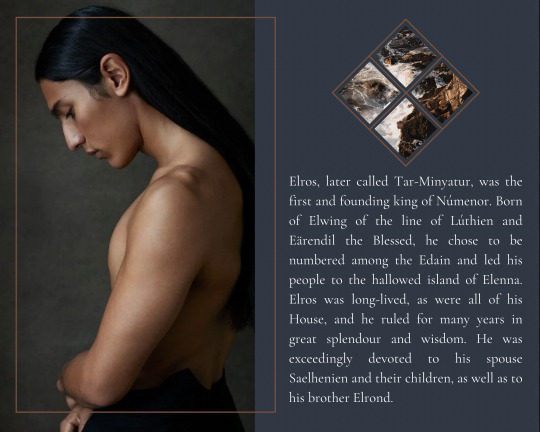
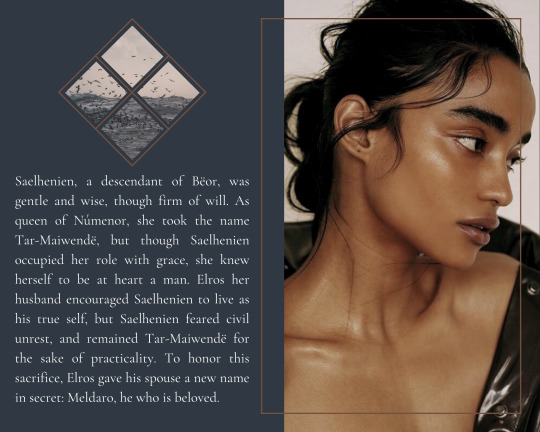
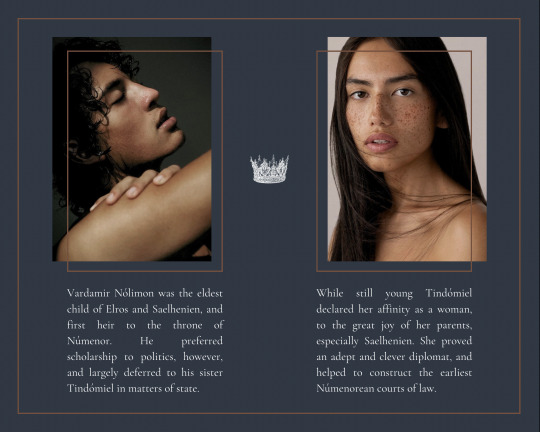
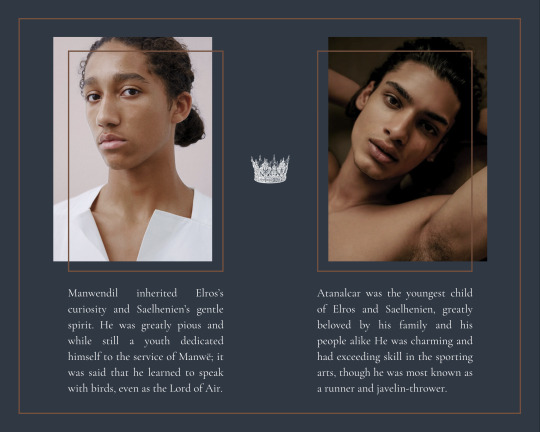
"But to Elros, who chose to be a king of Men, still a great span of years was allotted, many times that of the Men of Middle-earth; and all his line, the kings and lords of the royal house, had long life even according to the measure of the Númenóreans. But Elros lived five hundred years, and ruled the Númenóreans four hundred years and ten." - J.R.R. Tolkien, The Silmarillion, "Akallabêth"
@halfelvenweek day 3 ⇢ heritage + númenoreans || THE LINE OF ELROS
[ID: four graphics in shades of brown and desaturated dark blue.
1: A large image of Cherokee Jack framed by a brown rectangle covers the left side of the graphic. He is an aniyunwiya model with light brown skin and long, straight, dark brown hair. He is shown in profile, facing left and looking slightly down. The right side of the graphic shows a diamond-shaped image of ocean surf and rocks, divided into four sections and framed in brown. Below that, white serif text reads "Elros, later called Tar-Minyatur, was the first and founding king of Númenor. Born of Elwing of the line of Lúthien and Eärendil the Blessed, he chose to be numbered among the Edain and led his people to the hallowed island of Elenna. Elros was long-lived, as were all of his House, and he ruled for many years in great splendour and wisdom. He was exceedingly devoted to his spouse Saelhenien and their children, as well as to his brother Elrond."
2: Same format as Image 1, but the sides are switched. The large image shows indian model Shonali Singh. She has brown skin and black hair tied back in a bun, and is looking to the side. The small image shows birds flying over the ocean, and the text below it reads "Saelhenien, a descendant of Bëor, was gentle and wise, though firm of will. As queen of Númenor, she took the name Tar-Maiwendë, but though Saelhenien occupied her role with grace, she knew herself to be at heart a man. Elros her husband encouraged Saelhenien to live as his true self, but Saelhenien feared civil unrest, and remained Tar-Maiwendë for the sake of practicality. To honor this sacrifice, Elros gave his spouse a new name in secret: Meldaro, he who is beloved."
3: The whole graphic is framed in brown, and contains two smaller rectangular images each with their own frame. The image on the right side shows Reef Titcomb, a young man with brown skin and dark curly hair, facing to the side with his eyes closed and head lifted. White text below the image reads "Vardamir Nólimon was the eldest child of Elros and Saelhenien, and first heir to the throne of Númenor. He preferred scholarship to politics, however, and largely deferred to his sister Tindómiel in matters of state." The second image shows Logan Alcosiba, a native hawaiian/filipino/mixed european model with freckled brown skin and straight dark hair. She is looking at the viewer intently, turned slightly to one side. Text below the image reads "While still young Tindómiel declared her affinity as a woman, to the great joy of her parents, especially Saelhenien. She proved an adept and clever diplomat, and helped to construct the earliest Númenorean courts of law." Between the two pictures is a small drawing of a white crown.
4: Same format as Image 3, but this time the first image shows Josh Armstrong, a young man with brown skin and dark brown curly hair tied back in a bun. He is wearing a white shirt and looking at the viewer with a thoughtful expression. Text below the image reads "Manwendil inherited Elros’s curiosity and Saelhenien’s gentle spirit. He was greatly pious and while still a youth dedicated himself to the service of Manwë; it was said that he learned to speak with birds, even as the Lord of Air." The second picture shows Mase Somanlall, a guyanese/canadian model with brown skin and wavy dark hair. He is leaning back with his arms folded behind his head, looking up at the viewer. Text reads "Atanalcar was the youngest child of Elros and Saelhenien, greatly beloved by his family and his people alike He was charming and had exceeding skill in the sporting arts, though he was most known as a runner and javelin-thrower." //End ID]
#halfelvenweek#elros#elros's wife#vardamir#vardamir nólimon#tindómiel#manwendil#atanalcar#textual ghosts#line of elros#númenor#the silmarillion#akallabêth#mepoc#peredhel#tolkienedit#silmedit#oneringnet#tolkiensource#sourcetolkien#fantasyedit#litedit#brought to you by me#edits with the wild hunt#the professor's world#graphics#described#fc: cherokee jack#fc: shonali singh#fc: reef titcomb
37 notes
·
View notes
Text

Welcome to the Numenor Week! Event created for fans of the tragic and beautiful story of the Land of the Gift, from its birth to its downfall.
The event will run from May 26 to June 1, and will accept all the type of fanworks (fanarts, fanfictions, edits, gifsets, remix, etc etc). please remember to tag @numenorweek and to add #numenorweek and #numenorweek2025 in the first 10 tags of your post. NSFW contents are welcomed, but mind to tag them or to put them under a cut. It's ok to submit Rings of Power contents because the show follows the events of the Akallabeth, but only if said content is about the Numenorean characters.
Numenor Week Prompts (those are just suggestions, you can follow them or either discard them completely)
Day 1: Elros Tar-Minyatur | The Line of Elros || Characters: Elros, Elwing, Eärendil, Vardamir Nólimon, Tindómiel, Manwendil, Atanalcar || Prompts: The Choice of the Peredhili - Mortality & Immortality - Rites at the Meneltarma - Kingship - The Legacy of Eärendil
Day 2: The Mariner's Wife | Aldarion and Erendis || Characters: Tar-Aldarion, Erendis, Tar-Ancalimë, Hallacar, Tar-Meneldur, Almarian, Ailinel & Almiel || Prompts: Costumes and traditions of the Numenoreans, the Guild of the Venturers, laws of succession, expansion of the Numenoreans in Middle Earth, Uinen and the Uinendili
Day 3: Daughters of the Great | The Ruling Queens of Numenor || Characters: Tar-Ancalimë, Tar-Telperiën, Tar-Vanimeldë, Tar-Míriel, Silmariën || Prompts: the role of women in Númenor, usurpation, Queenship, the known and the forgotten women of the line of Elros
Day 4: The Faithful | Lords of Andunie || Characters: Inzilbeth, Amandil, Elendil, Tar-Palantir, Eärendur, Lindórië || Prompts: Secrecy, worship of the Valar, the White Tree, Pelargir, Strife between kin
Day 5: The King's Men | The Ban of the Valar || Characters: Tar- Atanamir the Great, Ar-Adûnakhôr, Ar-Gimilzôr, Gimilkhâd, the Witch King of Angmar || Prompts: Cult of the Dead, Fear of the unknown, Umbar, Pride, Ban of the Quenya, Nazgûl
Day 6: Akallabeth | The Downfall || Characters: Tar-Míriel, Ar-Pharazôn, Sauron, Amandil, Elendil, Elentir, Sauron/Tar-Mairon. || Prompts: Hybris, the cutting of the White Tree, the imprisonment of Sauron, Worship of Melkor, War against the Valar
Day 7: The Realms in Exile | The Line of Isildur and Anarion ||Characters: Elendil, Isildur, Anarion, Valandil, Meneldil, Ohtar ||Prompts: Exile, Gondor and Arnor, the Last Alliance of Elves and Men, Estel
If you have any questions, feel free to send an ask in my askbox!
-- banner artwork by Felix Sotomayor
#numenorweek#numenorweek2025#lord of the rings#silmarillion#the silmarillion#jrr tolkien#tolkien#middle earth#numenor#numenoreans#tar miriel#tar mairon#tar míriel#ar pharazon#sauron
87 notes
·
View notes
Text
Finrod Felagund. "Philosophic discourse regarding the enmity of Orcs with Elves." The Philosophy of Finrod Felagund. 2nd ed., edited and translated by Vardamir Nólimon, Armenelos, S.A. 130.
[Ed. note: Private papers of Finrod Felagund. Written in his own hand. Dated to the season of Firith in the year 455, shortly before the Dagor Bragollach.]
Fact: According to the lore of our people from the days of Cuiviénen, the Enemy fashioned Orc-kind by his torture and slow corruption of Elven captives.
Question: How did our people learn this lore? Can it be that any ever escaped from the depths of Utumno to serve as witness?
Fact: In the lore we got of the Valar there is to my knowledge no teaching regarding the origins of Orc-kind.
Conjecture: It may be that our lore is not reliable on this point.
Fact: There are a few among us who dwelt at Cuiviénen, and others of their number abide yet in Aman; none of them have to my knowledge disputed the accuracy of our lore on this matter.
Fact: The fëar of Elves and Men have their differences from one another, but none so fundamental as the distinction between the fëar of the Eruhíni and the spirits of the non-speaking creatures. The spirits of non-speaking creatures cannot properly be called fëar, as the distinction in question is one of kind and not of degree. (Indeed fëar cannot be spoken of at all in terms of degree or size, as each fëa is itself indivisible.)
Fact: The lore we got of the Valar tells us that the fëa cannot be destroyed by any means.
Fact: Also of that lore, we know that the Enemy cannot truly create, only twist in mockery what has been created.
Fact: Also of that lore, we know that the Dwarves have their fëar of Ilúvatar alone, and not of Aulë. Before the granting of their fëar they could not speak, nor had they any will of their own, but could only obey the will of Aulë.
Fact: Orcs speak, and there is sense behind their words.
[continued on Ao3]
#finrod#finrod felagund#silm fanfic#silmarillion fanfiction#silm#silmarillion#the silmarillion#tolkien#tolkien fanfic#tolkien fanfiction#my writing#my fic#in which finrod is a NERD and also a very good heart#in-universe philosophy as angst is after all his Thing (as well as andreth’s)#finrod is my son and i give him my orc emotions. i do this because i love him
167 notes
·
View notes
Text
Sometimes I like to think of some of the Maiar being worshipped/venerated in Middle Earth almost as much as the Valar. Sailors from Dol Amroth and Umbar pray to Uinen and Ossë alongside Ulmo. The Númenóreans had hymns to Eönwë, their guide and teacher from on high. And of course every culture has something to say about Arien and Tilion, particularly about Arien, and particularly Mannish cultures. They are the Children of the Sun, after all, of course they have stories about the maiden of fire who brought light and banished the unholy darkness, about the untamed hunter who was not hindered even by the shadows that sought to drag him down. Sometimes I like to think of Saruman in Orthanc, with all the Númenórean technology and star charts and calendars based on the studies of Vardamir Nólimon, staring up at the heavens, not to study the stars, Varda's handiwork, but to follow, with fascination and envy, the paths of Arien and Tilion, known now by many names in many tongues. He knew them, is one of them, and yet they are as gods now, or their children at least, the lantern-bearers of the world of Men, and they have been so since long before he first arrived on the shores of Middle Earth. To the east, the Rohirrim embroider Arien's light onto their banners and their blankets and emblazon the sun upon their shields. To the west, the Dunlendings wear amulets and ink tattoos in the phases of the moon, that the pale huntsman may favour them with sharp eyes and unconquerable stride. They are gods, and he is little more than a strange, wise old man, or maybe an elf, one disproportionately withered by the passage of time. It irks him. It does.
#i just have a lot of thoughts about arien. and tilion. and saruman. and how weird it must be for someone you might have once known to be#lighting up the entire world. while you have arthritis#lotr#arien#tilion#saruman
13 notes
·
View notes
Text
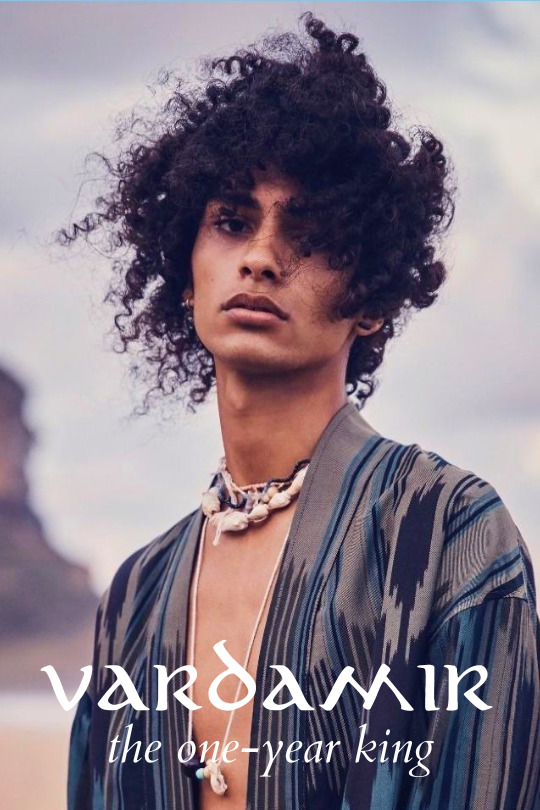

@tolkiengenweek day four | solo | vardamir
He was born in the year 61 of the Second Age and died in 471. He was called Nólimon for his chief love was for ancient lore, which he gathered from Elves and Men. Upon the departure of Elros, being then 381 years of age, he did not ascend the throne, but gave the sceptre to his son. He is nonetheless accounted the second of the Kings, and is deemed to have reigned one year. It remained the custom thereafter until the days. of Tar-Atanamir that the King should yield the sceptre to his successor before he died; and the Kings died of free will while yet an vigour of mind.
—Unfinished Tales
#tolkiengenweek#tolkienedit#oneringnet#silmedit#vardamir#vardamir nolimon#silm#silmarillion#the silmarillion#my edit#tefain nin#model: tre samuels
59 notes
·
View notes
Text



@halfelvenweek, day 7 - Vardamir
He was born in the year 61 of the Second Age and died in 471. He was called Nólimon for his chief love was for ancient lore, which he gathered from Elves and Men. Upon the departure of Elros, being then 381 years of age, he did not ascend the throne, but gave the sceptre to his son. He is nonetheless accounted the second of the Kings, and is deemed to have reigned one year. It remained the custom thereafter until the days of Tar-Atanamir that the King should yield the sceptre to his successor before he died; and the Kings died of free will while yet in vigour of mind.
#this was supposed to be for day three but i am a dumbass#convinced to post this by wigilda who is now suffering as my official designer to help with colours#so much about me making a post for every day of half-elven week#rip creativity#halfelvenweek#vardamir#tolkien#wigilda appreciation agenda because i am making her suffer
36 notes
·
View notes
Text
“The Earlier Generations of the Line of Elros”
Tolkien Gateway cites this part of Unfinished Tales as their source for Elros’s children, listed as Vardamir Nólimon, Tindómiel, Manwendil, Atanalcar. It’s listed as the only source for these names, and mentioned as a ‘chart’. But my copy of Unfinished Tales (pub. 1982) doesn’t have a ‘The Earlier Generations of the Line of Elros’ so far as I can see - only ‘The Line of Elros’ pp218-227. No chart. Nor does the index mention Tindómiel, Manwendil, or Atanalcar, only Vardamir. I ran a search through HoME, and couldn’t find any of those names in there either, even when I searched for Elros and checked under every reference to him in HoME. Is there a later edition of Unfinished Tales with this ‘chart’ in it? Does anyone have a copy? Tagging, in faint hope, @grundyscribbling @nimium-amatrix-ingenii-sui @vardasvapors @heartofoshun but if someone else has a copy and can check this I would be very grateful! Perhaps the names come from an earlier draft? I’d love to know exactly what was said about them!
21 notes
·
View notes
Photo

私设 - Vardamir Nólimon · ♑
他用智者的眼睛看人,星辰大海翻涌在他的掌心。
第一学霸,倾其毕生收集考证史料,对权势和武技都没有兴趣。喜欢父亲的努门诺尔但是不说,喜欢精灵的一切但是不说,喜欢终不得见的爱隆大伯但是不说。
25岁成年时,接手了努门诺尔皇家图书馆(背景是借圣三一的图书馆,古老又低奢,也是看出过神 详细设定点我),小时候怎么都不喜欢出门,年龄越大反而天天往外跑,可能是个读万卷书行万里路的践行者。
总的来说瓦尔达米尔是个文臣气质的青年,抛开体格差不论,一身都是青年时期爱隆的书卷��,好几次逆光里把他爹看得一愣一愣。
年逾300开始授业,后期尤以航造为重,只因他深知对一个初期没有船的岛国而言这可谓最迫切的需求。在生命的最后几年,还只能算是幼年的维安图尔师承于他,获其倾囊相授。他崇拜他,然后送走他。
“老师,为什么我们一定要去航海?”稚嫩的维安图尔,蓝色眼眸里落满了星光。 “因着吾辈本就自那里来。”诺里蒙老去的双手缓慢地摩挲着他的发顶。
64 notes
·
View notes
Text
All true, but I excluded him because he's the only one with a canonical death date and information about his aging/death (he didn't actually rule Númenor because he was already elderly when Elros died, and immediately passed the Sceptre to his son Amandil and enjoyed his old age before dying at 410 years old, which is still a pretty good run!). We don't have any death dates or information about the later years of his younger siblings, though.
Switching fandoms for today's poll because I feel like it: in Nature of Middle-earth, Tolkien drops the absolute bombshell (for me!!) that Elros's children did get to choose between mortality and immortality, just like Elrond's. Elros's firstborn definitely chose mortality (he died of old age at over 400 years old), but we have no death dates for any of his other children.
If you were going to headcanon that one of Elros's three younger children did choose immortality (and is either keeping a low profile or in Valinor by the Third Age), which child of Elros would it be?
If you want to headcanon that more than one of them chose to be counted among Elves, pick the one you care about the most and tell me who the other one is. If you still don't headcanon that any of them chose immortality, this poll is not for you!
#alsethwisson#respuestas#vardamir nólimon#legendarium blogging#poll nonsense#legendarium fanwank#unfinished tales#tindómiel#manwendil#atanalcar
43 notes
·
View notes
Text
First Lines
Thanks for tagging me, @zealouswerewolfcollector!!
Share the first lines of your last ten posted fics and see if there is a pattern.
-
Finrod Felagund. "Philosophic discourse regarding the enmity of Orcs with Elves." The Philosophy of Finrod Felagund. 2nd ed., edited and translated by Vardamir Nólimon, Armenelos, S.A. 130.
[Ed. note: Private papers of Finrod Felagund.
i'd have taken out your heart of flesh, put in a heart of stone
“Oh, first let pass the black, black horse, and then let pass the brown, but quickly run to the milk-white steed, pull ye his rider down.”
his knife in your back
The knife in your back.
Impossibility
Four years ago, Cousin Maedhros was swallowed by a maw-mouth during graduation.
Well-Formed One
My Edain tell a tale for every scar.
Fëanorian Bredliks
nor foe nor frend
Dreaming, Waking
I wake with my face wet and my heart hammering.
neither in dreams nor stories
I’d done my best to go away inside myself while Chernobog fought the Staryk, but when at last it dragged my broken body back through the mirror, the sheer overwhelming relief of the palace’s relative warmth shocked me to full awareness.
in the deeps of time (and amidst the innumerable stars)
When there arose life, then arose the Force; for years uncounted it sang in the spaces between all living creatures, until at last some of them began to hear it.
Dawn
They find you barefoot in the morning dew; you stand unsupported, trembling, your face held up to the dawn.
Patterns... I don't know. I suppose I like to start in media res? And if I'm not doing that then it's probably because I'm playing with format somehow.
IDK who's done it yet, but I'll no-pressure tag @jaz-the-bard, @ceescedasticity, @halfelven, and anybody else who wants to!
#silm fanfic#silm#tolkien#my writing#this really made me realize how slow a writer i am#ten fics takes me back to july '22!#no shade to myself - i mean i'd love to be faster but that's just not how i work and i'm making an effort to come to terms with that#just - that's a startling timespan!#oh well
5 notes
·
View notes
Photo


@tolkienocweek day one | shipping | halyamórë, wife of vardamir
Halyamórë was the wife of Vardamir Nólimon, and nominally the second Queen of Númenor. She was a religious woman with a deep connection to Nienna who learned under the tutelage of elves from Aman who visited the isle of Elenna. She popularized the Noldorin tradition of veil-wearing among noblewomen, though her choice to veil was not one of fashion, but in honor of her Valië. Halyamórë was a quiet, thoughtful woman who spoke rarely, but her words when voiced were heeded by all, for she possessed great wisdom and empathy.
#tolkienocweek#tolkienedit#oneringnet#silmedit#silmarillion#silm#tolkien oc#silm oc#numenor#vardamir's wife#oc halyamore#nienna#my edit#my writing#edit writing#tefain nin#events
63 notes
·
View notes
Text
@cycas -> I share the Manwendil headcanon, am looking with interest at the Vardamir one too...
I take it as my duty to elaborate on Vardamir because I love him.
-------------------
Most of my headcanons about elven Vardamir come from his parallels with Elrond. The longest passage we have on Vardamir is in the Unfinished Tales, here:
He was born in the year 61 of the Second Age and died in 471. He was called Nólimon for his chief love was for ancient lore, which he gathered from Elves and Men. Upon the departure of Elros, being then 381 years of age, he did not ascend the throne, but gave the sceptre to his son. He is nonetheless accounted the second of the Kings, and is deemed to have reigned one year. It remained the custom thereafter until the days of Tar-Atanamir that the King should yield the sceptre to his successor before he died; and the Kings died of free will while yet in vigour of mind.
From this we have learned that:
he was greatly interested in learning and ancient lore - from both Elves and Men; and it was enough to earn him a new name
he got rid of the kingship very quickly
I also find it interesting that the later kings decided to follow Vardamir's example of yielding the sceptre before their death, even when they were still capable of ruling (until, of course, the later days of Númenor); but that's not important to this post
Coincidentally, Vardamir just happens to have an uncle who is a great lover of knowledge, associated with both Elves and Men (on a more regular basis than most of his kind), and there is a high chance that he was Gil-galad's heir but refused the crown (whether his reasons were personal or political; there simply not being enough elves left to rule. Elrond was the closest descendant of Finwë in line for the throne in Middle Earth, as well as possibly (but not certainly as Elwing was never a queen) being Thingol's oldest living heir).
I find it interesting that the paragraph specifically said that Vardamir learned from both Elves and Men, rather than of them - and while we don't have any information on how often did he came to be in contact with the Elves, I think it's likely it was enough for him to be comfortable to have nerdy historical conversations with them - and very likely he never had a real problem with it in the first place due to his heritage. This bit of information can be easily paralleled with Elrond - in more than one quote.
He was the Lord of Rivendell and mighty among both Elves and Men.
- FotR, Many Meetings
[spoken by Aragorn] 'Would that Elrond were here, for he is the eldest of all our race, and has the greater power.'
- RotK, The Houses of Healing
Mighty among Elves and Men, eldest of Aragorn's race (and Aragorn certainly isn't an elf)... He is constantly connected to both of the kindreds, as well as called Half-elven; and while the same can't be said about Vardamir, I am taking some liberties for my headcanons (and it's not as if Tollers ever specified).
Another interesting point would be their names. Yes, Elros has the el- in his name as well, but his name is more in the relation to the sea - meanwhile, Elrond, Star Dome, refers to the heavenly sky at night. Vardamir translates as Jewel of Varda - Varda, the Ainu most beloved by Elves, as well as directly linked to the stars.
It is because of his and Elrond's similarities that I have decided to headcanon Vardamir as belonging with Elves at heart (although he loves Men), whether he gets the Choice or not (and NoME ks the first time we see Tolkien mention the Choice as a possibility for him).
#vardamir#tolkien#numenor#elrond#this was supposed to be in a reblog of the og post but i accidentaly wrote it as a new one and i have no patience to copy it on the phone
32 notes
·
View notes
Text
I have a whole series of headcanon posts about it, but sometimes I still entertain myself with thinking about the origins of the House of the Stewards.
We know that the house’s formal name, the House of Húrin, came about through the heroic labours of the Steward Húrin of Emyn Arnen. At the time, the Stewardship was not hereditary, but he was such an icon that all later Stewards were chosen from among his descendants. As far as LOTR goes, his origins are vague; he was not directly from the line of Elendil, but is described as a “high Númenórean.”
I also have a post about that, but the short version is that Tolkien reuses the term “high Númenórean” without ever clarifying how it is distinct from simply “Númenórean” (e.g., Morwen of Lossarnach is also described this way). At the least, I think it indicates that Húrin already had high status of some kind in Gondorian society, quite apart from his personal service. The House of Húrin took Húrin’s name because he was so spectacular, not because he was its founder per se (sort of like how Aragorn’s house is named Telcontar after him, but pre-existed him as the House of Elendil).
It also indicates that the association between the House of the Stewards and Emyn Arnen goes back a reallyyyy long way. And before Faramir knows that he will be given Ithilien in its entirety and will remain Steward, he seems to assume that he and Éowyn will be living over the river in Ithilien. It’s generally assumed that he has the title of “Lord of Emyn Arnen” (used in passing in Appendix A) because Aragorn bestowed it on him with the princedom of Ithilien, but unless I’m misremembering something, it’s not stated that this is the case. It’s possible that this was the family’s ancestral rank, later overshadowed by the Ruling Stewardship.
So about all we know from LOTR is that they’re descended from a high-status Númenórean family from Emyn Arnen, which possibly was already in their possession at that point. However—
—Peoples of Middle-Earth supplies Tolkien’s various versions of the Appendices as he contracted them to what we have in LOTR. There, he says that the ancestors of the Stewards came from a family of “the ancient Elf-friends.” So, most likely, Húrin’s ancestors were a Faithful family back on Númenor who escaped and at some point settled in Emyn Arnen.
One of the versions also has the interesting detail that the Stewards were not in the direct line of descent from Elendil, but were ultimately “of royal origin.” There are a few ways to take this, but the most straightforward interpretation to me is that they were descended from Elros but not directly from Elendil; that is, they were one of the various Elros-descended families on Númenor, like the Lords of Andúnië. Since they were a Faithful family, too, they’re likely to have originally come from the western side of the island, also like the Lords of Andúnië, but would have been junior to them.
The Lords of Andúnië diverged from the royal house pretty early on. They were the descendants of Princess Silmariën, firstborn of Tar-Elendil. So a house junior to them would have to come from the generations earlier than that (a later generation would put the other house higher in the succession), or from Silmariën’s younger sister Isilmë.
This is more tentative, but I’m inclined to think that they also weren’t more immediate male-line descendants than the Lords of Andúnië (even with Tar-Aldarion’s law of equal succession, it seems like they would be more prominent if that were case). They could be descended from one of the early princesses or princes’ daughters/granddaughters, though.
We don’t usually know the names of the latter. e.g., Prince Aulendil, son of Vardamir Nólimon (son of Elros), had unnamed descendants that likely include female ones, but we don’t know anything about them. OTOH, we do know some of the names of his brother Nolondil’s female descendants: there’s Yávien daughter of Nolondil, Lindissë daughter of Nolondil’s son Axantur, and Írildë daughter of Axantur’s son Cemendur.
They’re all possibilities, though for me, it’s simplest to look at the princesses: Princess Isilmë (daughter of Tar-Elendil), Princess Mairen (daughter of Tar-Amandil), Princess Vardilmë (daughter of Vardamir Nólimon), and Princess Tindómiel (daughter of Elros). In my own head, I go with Princess Tindómiel as the true originator because a) I’m unreasonably attached to her and b) that provides some distance between the rise of the Stewards’ ancestors and the rise of the Lords of Andúnië. That’s pure headcanon, though.
Of course, you can simply ignore POME and just go with “Húrin was some kind of Númenórean aristocrat from Emyn Arnen, maybe Lord of Emyn Arnen, maybe not, who knows anything else.” But I think the Elrosian Faithful concept is really interesting, and it’s fun to come up with headcanons for their story.
#anghraine babbles#húrinionath#húrin of emyn arnen#legendarium blogging#/#//#///#////#/////#don't think i'll tag all the incidental names#so.#ondonórë blogging#númenórë#long post#anghraine's headcanons#peoples of middle earth
20 notes
·
View notes
Photo

Aesthetic post for a textual ghost: the unknown wife of Elros and mother to Vardamir Nólimon, Tindómiel, Atanalcar, and Manwendil
I imagined her as a Hadorian archivist in the early days of Númenor:
As far as public life went, she was remembered (when at all) as Istíriel, Tar-Minyatur’s beloved queen, decades his junior and dead of old age before half his life had passed. But among Númenórean academics, she loomed very large, even as they became increasingly male-dominated in later centuries. She was listed as founder or inspiration for nearly all their most beloved institutions. And it was rare to find a library or university without some commemoration of the loremaster Ithíriel, whose husband was a king.
#aesthetic post#ithíriel#elros's wife#legendariumladiesapril#anghraine's headcanons#legendarium blogging#anghraine's pics
76 notes
·
View notes
Text
Quenya name of the day: Nólimon
Nólimon: wise one
nólima: *wise, from nólë, lore, knowledge, wisdom, and the adjectival suffix -ima
-on: masculine substantival suffix
Nólimon is a masculine name, used once:
Vardamir Nólimon, eldest son of Elros Tar-Minyatur, technically accounted a king of Númenor though he in fact immediately surrendered the scepter to his own son. His sobriquet came from his love of ancient lore.
#nólimon#vardamir nólimon#quenya#quenya name of the day#jrr tolkien#middle earth#the silmarillion#unfinished tales#lord of the rings#he showed up on my dash today so#númenor#house of elros
8 notes
·
View notes